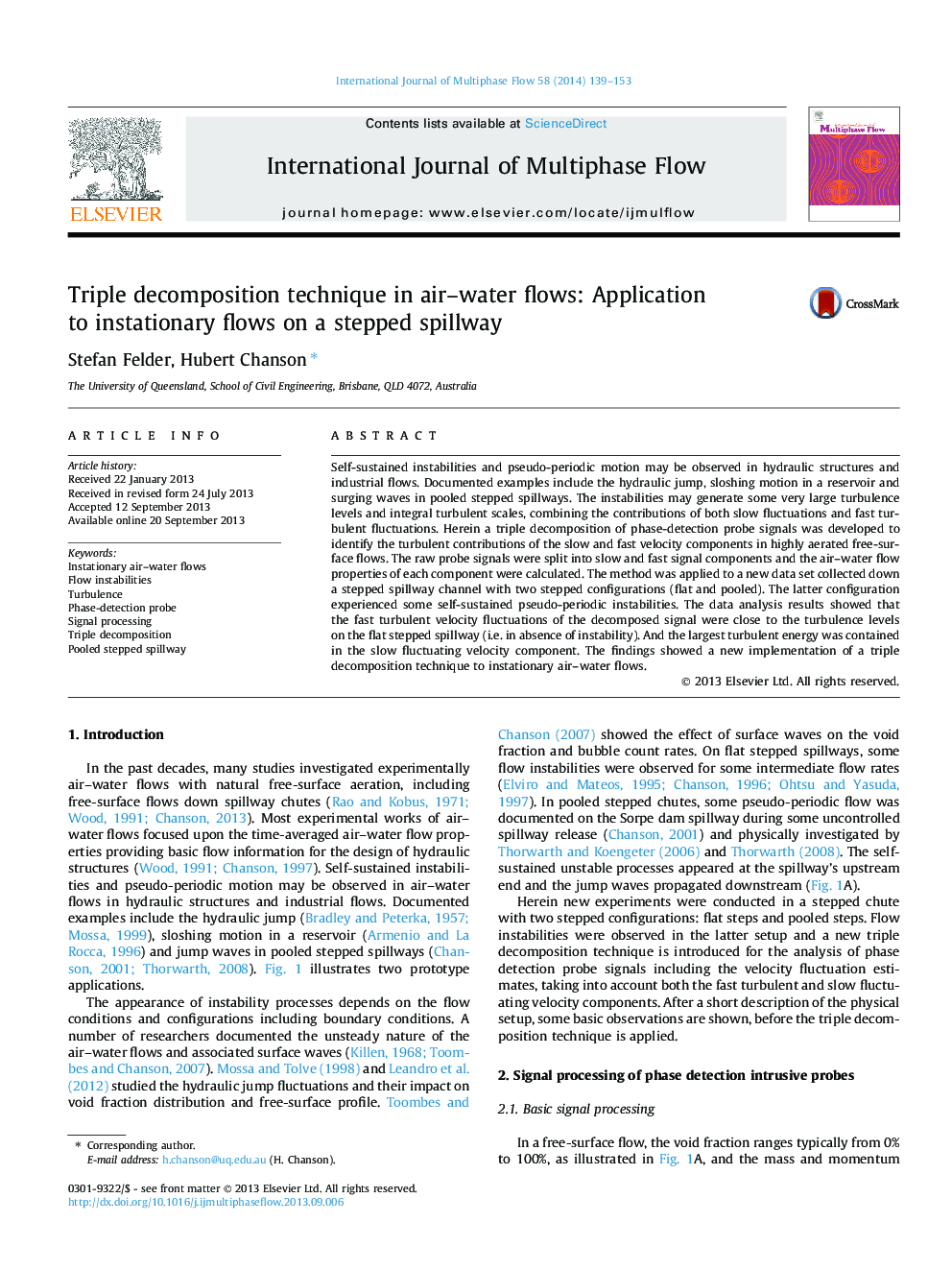| کد مقاله | کد نشریه | سال انتشار | مقاله انگلیسی | نسخه تمام متن |
|---|---|---|---|---|
| 667243 | 1458521 | 2014 | 15 صفحه PDF | دانلود رایگان |
عنوان انگلیسی مقاله ISI
Triple decomposition technique in air-water flows: Application to instationary flows on a stepped spillway
ترجمه فارسی عنوان
تکنیک تجزیه سه گانه در جریان هوا-آب: کاربرد جریانهای ثابت در یک سرریز پائین
دانلود مقاله + سفارش ترجمه
دانلود مقاله ISI انگلیسی
رایگان برای ایرانیان
کلمات کلیدی
جریان هوا مستطیلی جریان دارد، ناپایداری جریان آشفتگی، پروب تشخیص فاز، پردازش سیگنال، تجزیه سه گانه، هلی کوپتر پاشیده شده است،
ترجمه چکیده
عدم انطباق های خودمختاری و حرکت شبه دوره ای در سازه های هیدرولیکی و جریان های صنعتی مشاهده می شود. نمونه های مستند شامل جهش هیدرولیکی، حرکت لرزه ای در یک مخزن و امواج پرشده در مخازن مخلوط شده است. ناپایداری ممکن است برخی از سطوح آشفتگی بسیار زیاد و مقیاس های آشفتگی یکپارچه ایجاد کند، که ترکیبی از سهم هر دو از نوسانات آهسته و نوسانات نوظهور آشفته است. در اینجا، تجزیه سه گانه سیگنال های پروب تشخیص فاز برای شناسایی مشارکت آشفته مولفه های سرعت آهسته و سریع در جریان های آزاد هوا بسیار هوادهی توسعه داده شد. سیگنال های پروب خام به مولفه های سیگنال آهسته و سریع تقسیم شده و خواص جریان هوا-آب هر مولفه محاسبه شد. این روش به یک مجموعه داده جدید جمع آوری شده توسط یک کانال سرریز پله ای با دو پیکربندی پله ای (تخت و یکپارچه) اعمال شد. پیکربندی های اخیر برخی از عدم موفقیت های شبه دوره ای خودمختار را تجربه کرد. نتایج تجزیه و تحلیل داده ها نشان داد که نوسانات سرعت شتاب زده از سیگنال تجزیه شده نزدیک به سطوح آشفتگی در حوضچه صاف شده است (به عنوان مثال در صورت عدم بی ثباتی). و بزرگترین انرژی آشفته در عنصر سرعت نوسان سریع بود. یافته ها نشان می دهد که اجرای جدیدی از تکنیک تجزیه سه گانه به جریانات مستطیلی هوا-آب است.
موضوعات مرتبط
مهندسی و علوم پایه
مهندسی شیمی
جریان سیال و فرایندهای انتقال
چکیده انگلیسی
Self-sustained instabilities and pseudo-periodic motion may be observed in hydraulic structures and industrial flows. Documented examples include the hydraulic jump, sloshing motion in a reservoir and surging waves in pooled stepped spillways. The instabilities may generate some very large turbulence levels and integral turbulent scales, combining the contributions of both slow fluctuations and fast turbulent fluctuations. Herein a triple decomposition of phase-detection probe signals was developed to identify the turbulent contributions of the slow and fast velocity components in highly aerated free-surface flows. The raw probe signals were split into slow and fast signal components and the air-water flow properties of each component were calculated. The method was applied to a new data set collected down a stepped spillway channel with two stepped configurations (flat and pooled). The latter configuration experienced some self-sustained pseudo-periodic instabilities. The data analysis results showed that the fast turbulent velocity fluctuations of the decomposed signal were close to the turbulence levels on the flat stepped spillway (i.e. in absence of instability). And the largest turbulent energy was contained in the slow fluctuating velocity component. The findings showed a new implementation of a triple decomposition technique to instationary air-water flows.
ناشر
Database: Elsevier - ScienceDirect (ساینس دایرکت)
Journal: International Journal of Multiphase Flow - Volume 58, January 2014, Pages 139-153
Journal: International Journal of Multiphase Flow - Volume 58, January 2014, Pages 139-153
نویسندگان
Stefan Felder, Hubert Chanson,
